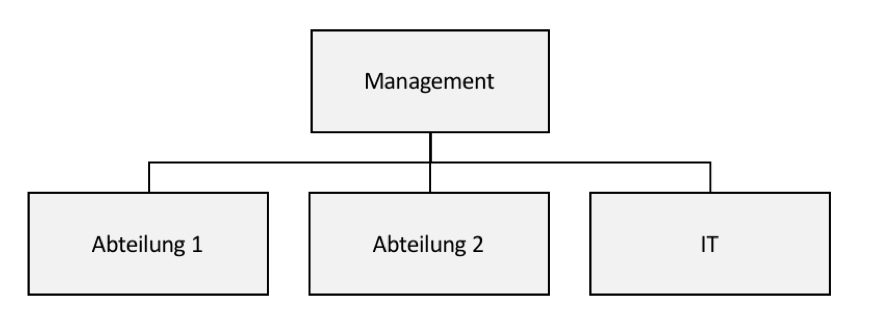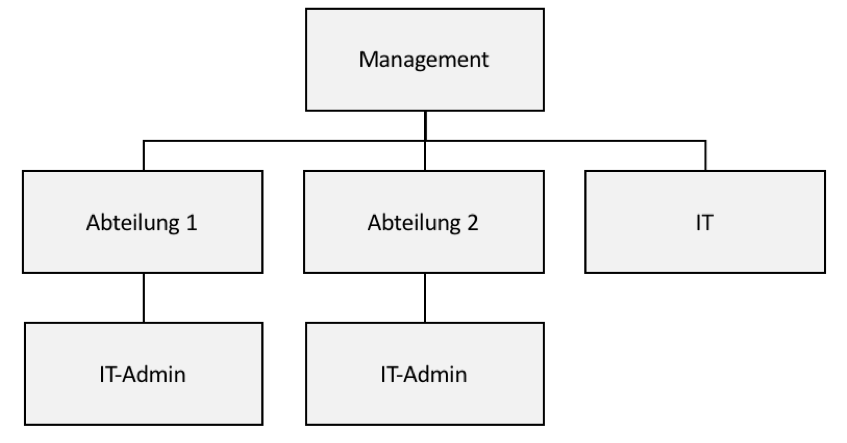Modern IT is characterized by changed framework conditions. In addition to the pressure of profitability, IT should also be innovative and demonstrate a high level of service mentality. Basically, one reads in many magazines that the modern IT organization should be as central as necessary and as decentralized as necessary. But how should that work and what form of IT organization is there? There is a distinction between IT organizational forms and IT organizational models. For completeness, I recommend reading the other article as well.
Reading tip: IT organizational models
Decentralized IT organization
In the decentralized IT, there is clear management and assignment of orders to IT. In short, each unit has its own IT (see figure). The advantage is that these are close to the line and therefore often have a higher orientation to the department. However, the department is then disciplinary responsible for IT, which reduces the importance of this. There is also the risk of redundancy and silo thinking.

Central IT organization
The central IT is an IT department for the entire company. In this way, the departments transmit requirements to the IT. IT has its own staff and resources. She also implements her own strategy and plans the overall architecture. As a rule, there is no silo thinking and IT comes from a single source. Cross-divisional solutions could also be found. However, greater effort is required for coordination in order to prevent IT blindness and solutions that are too general, i.e. not perfectly tailored to the specialist area, but rather compromise solutions. In this model, however, IT is also very “powerful” in the company.

Hybrid IT organization
As central as necessary and as decentralized as possible partially applies to the hybrid IT organizational form. IT admins are deployed for each area to adapt the IT to the department. This means that at least the IT can be designed more individually without being directly decentralized. The advantages are the proximity to the line and the fact that the admins can talk to the IT technically on an equal footing, which is often more difficult for the department if there are no IT switchers employed there. The dangers are of course political effects such as power struggles and renewed silo thinking.

IT organization project
In this approach, IT is retained as the implementer and each department has individual IT admins. However, there is also an IT office which, as a cross-sectional department, plans IT in the company together with the specialist departments. IT is independent, but has the IT office as the “advocate” for the departments. In this way, silo thinking can be avoided, but the IT office will tend to establish itself as a place of power struggles, as it has to represent the departments. Opportunities in this model are definitely cross-departmental solutions and synergies.

IT organizational forms – selection process
In order to decide on a model, you should only consider the importance of IT for the company’s business model. Of course, almost nothing works in a digital world without IT, but it still doesn’t always play the decisive role. Let’s think of cat food, which is primarily controlled by production and logistics and supported by IT. It is different with Apple, which is a software company.
Reading tip: What is an IT organization
Example 1: High importance for day-to-day business and low for strategy
A strongly software-oriented production or a company that provides products or services with the help of software could be used here. A decentralized or hybrid IT organization is worthwhile here.
Example 2: Great importance for day-to-day business and strategy
This is usually an IT company such as a software house with a software product. IT is the central point here. A central or hybrid IT organization is recommended here.
Example 3: Low importance for day-to-day business and low for strategy
This can be a logistics or food factory, for example, which manufactures products and supports IT with small, less noticeable functions. A decentralized or hybrid IT organization is recommended here.
Example 4: Low importance for day-to-day business and high importance for strategy
If this should occur, it could be an IT consulting company with knowledge products, i.e. advice. Project IT organization and central IT can be particularly worthwhile here.
Reading tip: IT organization 2020
[yop_poll id=”36″]
[werbung] Verwendete Quellen anzeigen



